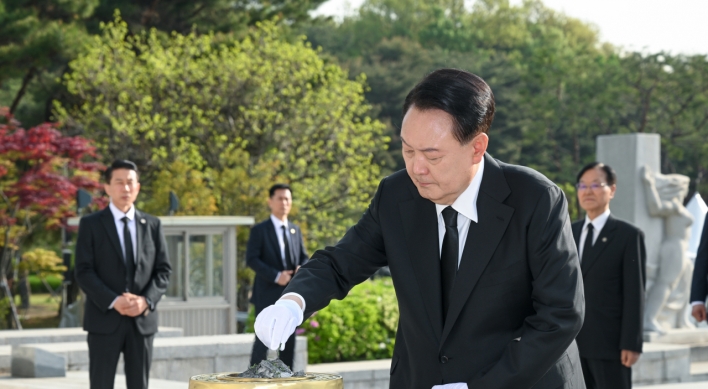Lifting of US missile restrictions signifies Seoul's missile sovereignty, Washington's China strategy: experts
By YonhapPublished : May 22, 2021 - 10:48

Lifting of US missile restrictions signifies Seoul's missile sovereignty, Washington's China strategy: experts
The full lifting of US restrictions on South Korean missiles is expected to beef up Seoul's defense capabilities by allowing it to secure longer-range missiles that can fly beyond the Korean Peninsula, experts said Saturday.
The decision is also seen as part of the US strategy to counter China, and South Korea's deployment of longer-range missiles could bring the country further into the great power game between Washington and Beijing, the experts said.
Following a summit with US President Joe Biden, President Moon Jae-in announced their decision to scrap the bilateral "missile guidelines," which ban South Korea from developing or possessing ballistic missiles with a maximum range greater than 800 kilometers.
Moon hailed the lifting as a "symbolic and substantive" demonstration of the robustness of the alliance.
"The decision means the removal of 'security shackles' for South Korea and allows us to fully regain our missile autonomy. Longer-range missiles will help boost our defense power and diplomatic leverage," a former senior defense ministry official said.
The missile restrictions were first introduced in 1979 as South Korea sought to secure US missile technologies for its own missile development. In return, Seoul agreed to limit the maximum flight range of its missiles to 180 km and the weight of warheads to 500 kg.
In the face of evolving nuclear and missile threats by North Korea, however, Seoul and Washington revised the guidelines four times through last year to extend the range to 800 km, scrap the limit on warhead weight and lift the ban on using solid fuel for space launch vehicles.
Now that all those restrictions have been terminated, South Korea can develop and possess any type of missile, including intercontinental ballistic missiles and advanced submarine-launched ballistic missiles.
"Longer ranges mean that we can launch missiles from safer locations in the rear, which will give us greater strategic flexibility and enable us to better prepare for threats from North Korea and others," he said.
Currently, the ground-based missile Hyunmoo-4 boasts the longest flight range of 800 km among homegrown missiles. The weapon with a 2-ton payload was successfully developed last year.
Professor Huh Hwan-il of Chungnam National University also pointed to its impact on the space science field, saying that the advance in missile technologies will positively affect space rocket projects and that "no conditions mean that scientists can be more creative."
Experts also call for paying attention to what the US seeks to gain through the latest move, with some raising concerns over its possible impact on the relations between Seoul and Beijing.
"Missiles with a maximum range of 800 km can reach any part of North Korea when fired from our territory. So, the US flexibility indicates that it sees beyond the Korean Peninsula," Chang Young-keun, a missile expert at Korea Aerospace University, said. Beijing and Seoul are around 950 km apart.
The US has been working to establish air defense systems in the Asia-Pacific region to maintain deterrence against China.
For the goal, the US withdrew in 2019 from the Intermediate-Range Nuclear Forces treaty with Russia, and has been trying to deploy intermediate-range missiles in Asia and other parts of the world, which sparked strong opposition from Beijing and Moscow.
"Under the circumstances, the enhancement of missile capabilities by its allies will surely be in the interests of the US," Park Won-gon, a professor of international politics at Handong Global University, said.
Kim Heung-kyu, professor of Ajou University, even warned that South Korea may again experience frayed ties with Beijing, just as it did in 2016 when it decided to host the US missile defense system of the Terminal High Altitude Area Defense.
"We could be further embroiled in the escalating tensions between Washington and Beijing. How to strike a balance is quite a tall order," he said. (Yonhap)
The full lifting of US restrictions on South Korean missiles is expected to beef up Seoul's defense capabilities by allowing it to secure longer-range missiles that can fly beyond the Korean Peninsula, experts said Saturday.
The decision is also seen as part of the US strategy to counter China, and South Korea's deployment of longer-range missiles could bring the country further into the great power game between Washington and Beijing, the experts said.
Following a summit with US President Joe Biden, President Moon Jae-in announced their decision to scrap the bilateral "missile guidelines," which ban South Korea from developing or possessing ballistic missiles with a maximum range greater than 800 kilometers.
Moon hailed the lifting as a "symbolic and substantive" demonstration of the robustness of the alliance.
"The decision means the removal of 'security shackles' for South Korea and allows us to fully regain our missile autonomy. Longer-range missiles will help boost our defense power and diplomatic leverage," a former senior defense ministry official said.
The missile restrictions were first introduced in 1979 as South Korea sought to secure US missile technologies for its own missile development. In return, Seoul agreed to limit the maximum flight range of its missiles to 180 km and the weight of warheads to 500 kg.
In the face of evolving nuclear and missile threats by North Korea, however, Seoul and Washington revised the guidelines four times through last year to extend the range to 800 km, scrap the limit on warhead weight and lift the ban on using solid fuel for space launch vehicles.
Now that all those restrictions have been terminated, South Korea can develop and possess any type of missile, including intercontinental ballistic missiles and advanced submarine-launched ballistic missiles.
"Longer ranges mean that we can launch missiles from safer locations in the rear, which will give us greater strategic flexibility and enable us to better prepare for threats from North Korea and others," he said.
Currently, the ground-based missile Hyunmoo-4 boasts the longest flight range of 800 km among homegrown missiles. The weapon with a 2-ton payload was successfully developed last year.
Professor Huh Hwan-il of Chungnam National University also pointed to its impact on the space science field, saying that the advance in missile technologies will positively affect space rocket projects and that "no conditions mean that scientists can be more creative."
Experts also call for paying attention to what the US seeks to gain through the latest move, with some raising concerns over its possible impact on the relations between Seoul and Beijing.
"Missiles with a maximum range of 800 km can reach any part of North Korea when fired from our territory. So, the US flexibility indicates that it sees beyond the Korean Peninsula," Chang Young-keun, a missile expert at Korea Aerospace University, said. Beijing and Seoul are around 950 km apart.
The US has been working to establish air defense systems in the Asia-Pacific region to maintain deterrence against China.
For the goal, the US withdrew in 2019 from the Intermediate-Range Nuclear Forces treaty with Russia, and has been trying to deploy intermediate-range missiles in Asia and other parts of the world, which sparked strong opposition from Beijing and Moscow.
"Under the circumstances, the enhancement of missile capabilities by its allies will surely be in the interests of the US," Park Won-gon, a professor of international politics at Handong Global University, said.
Kim Heung-kyu, professor of Ajou University, even warned that South Korea may again experience frayed ties with Beijing, just as it did in 2016 when it decided to host the US missile defense system of the Terminal High Altitude Area Defense.
"We could be further embroiled in the escalating tensions between Washington and Beijing. How to strike a balance is quite a tall order," he said. (Yonhap)







![[Graphic News] More Koreans say they plan long-distance trips this year](http://res.heraldm.com/phpwas/restmb_idxmake.php?idx=644&simg=/content/image/2024/04/17/20240417050828_0.gif&u=)
![[KH Explains] Hyundai's full hybrid edge to pay off amid slow transition to pure EVs](http://res.heraldm.com/phpwas/restmb_idxmake.php?idx=644&simg=/content/image/2024/04/18/20240418050645_0.jpg&u=20240419100350)






![[From the Scene] Monks, Buddhists hail return of remains of Buddhas](http://res.heraldm.com/phpwas/restmb_idxmake.php?idx=652&simg=/content/image/2024/04/19/20240419050617_0.jpg&u=20240419175937)

![[KH Explains] Hyundai's full hybrid edge to pay off amid slow transition to pure EVs](http://res.heraldm.com/phpwas/restmb_idxmake.php?idx=652&simg=/content/image/2024/04/18/20240418050645_0.jpg&u=20240419100350)

![[Today’s K-pop] Illit drops debut single remix](http://res.heraldm.com/phpwas/restmb_idxmake.php?idx=642&simg=/content/image/2024/04/19/20240419050612_0.jpg&u=)